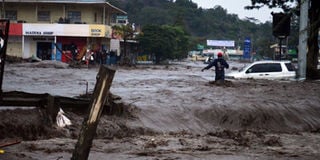We do need a disaster management policy

Flash floods that occurred in the wake of heavy rains in Narok County. Three people were killed by floods in Talek Village, Narok County after a heavy downpour on Monday, November 2, 2015. PHOTO | GEORGE SAYAGIE | NATION
What you need to know:
- Lack of an integrated and coordinated approach to disaster risk management has exposed the country to a casual approach that relies on costly ad hoc measures to handle unexpected disasters.
- During the Third United Nations World Conference on Disaster Risk Reduction held in Sendai, Japan in March 2015, President Uhuru Kenyatta promised that Kenya would scale up efforts to reduce disasters and mitigate risks.
- The Ethiopia policy contains greater emphasis on the delegation of powers to the regional and local levels, which can as well be successfully done in Kenya with the devolved government.
The recent flash floods in Narok and Mandera would not have killed over a dozen people if a national disaster risk management policy that was drafted and reviewed 15 years ago was is in place.
The comprehensive policy document is gathering dust and is yet to reach Parliament for debate and legislation despite the fact that repeated disasters have followed us every year.
Lack of an integrated and coordinated approach to disaster risk management has exposed the country to a casual approach that relies on costly ad hoc measures to handle unexpected disasters. This leaves us with few guidelines that can help avert huge losses from future disasters.
There is an admission by the government of the poor state of affairs. During the Third United Nations World Conference on Disaster Risk Reduction held in Sendai, Japan in March 2015, President Uhuru Kenyatta promised that Kenya would scale up efforts to reduce disasters and mitigate risks. However, the President’s words are yet to be followed by any concrete actions in the wake of what we have recently experienced.
It is essential that Kenya emulates a country like Ethiopia, one of the most successful countries in Africa on disaster risk management, which enacted its first policy in 1974. Unlike Kenya, Ethiopia has highly progressive legislation to mitigate risk that is tied to food security and youth employment.
This has allowed the country to provide a sufficient budgetary allocation to the disaster risk management. Rather than being seen as an expense, the huge allocation is seen as an investment.
Back here in Kenya, the country spends immense resources from the government, private sector and donor agencies to provide emergency relief when disaster strikes, resources that can be used to finance long-term preventive measures.
The draft policy in Kenya proposes the establishment of a functional national disaster preparedness and management centre, to coordinate and convey information on disaster risk management. Such an agency has the capacity to enhance an inter-ministerial and multi-sectorial approach.
The Ethiopia policy contains greater emphasis on the delegation of powers to the regional and local levels, which can as well be successfully done in Kenya with the devolved government.
In Ethiopia, the legislation has also created a coordinating body, National Disaster Prevention and Preparedness Commission with representatives drawn from various players, including the private sector and non-governmental organisations.
Kenya’s draft policy also proposes such a body that can enable the government to network with key actors including the private sector, who have in the past provided immense resources, the media, academia and the public.
With the presence of a strong institutional framework on disaster risk management, more resources can be allocated to education and research.
The country can also adopt appropriate technology to detect disasters before they occur. Equally important, an elaborate disaster risk management approach can also address social problems such as unemployment by engaging youth either in voluntary and actual employment.
Mr Obonyo is a Global Young Diplomat and UNISDR’s External Adviser on Youth. [email protected]





